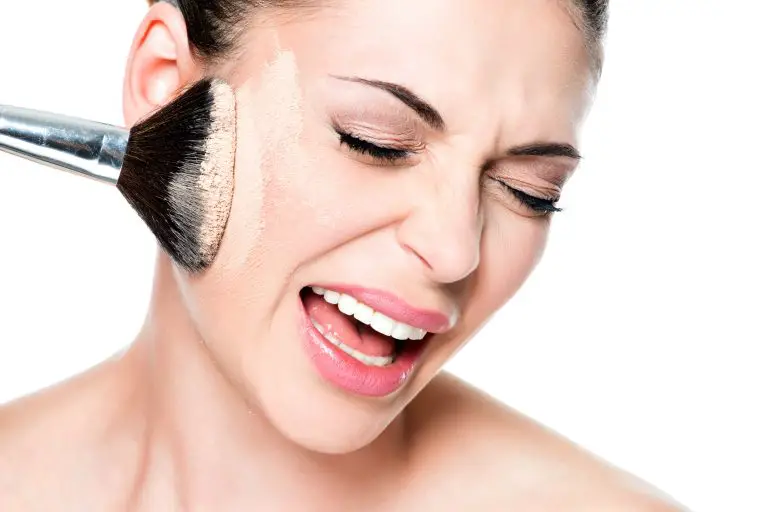At times, despite your best efforts for a flawless makeup look, you end up with cakey makeup. The telltale signs include patchy, textured skin, the obvious appearance of pores or fine lines, or the dreaded lines of demarcation. It could be because of a few different reasons, but it’s something you don’t need to fret about. There are tactics to fixing cakey makeup, and you don’t need to be a professional makeup artist for it either.
What is Cakey Makeup?
Usually, a foundation that looks thick, heavy, and quite noticeable gives a cakey makeup look. This also happens when too much product is used or the right product isn’t used for your skin texture or skin type. Makeup that’s creasing, flaking, sliding around, or breaking up on your face sums up cakey makeup.
Why You’ve Got Cakey Makeup?
Here are a few reasons for cakey makeup and some fixes and tips to avoid cakey makeup.
1. Dry Skin
If you’ve got dry, crusty, or dehydrated skin, a full coverage foundation is probably not going to help out much. The longer dry skin has makeup on, the worse your skin gets affected. Foundation and thick powders impact by seeping into dry skin, causing your makeup to appear cakey.
Additionally, dead skin cells on the skin’s surface result in a layer of rough texture, not letting for a smooth application of makeup.
Tips for Fixing Makeup Over Dry Skin
The obvious fix for dry, dehydrated skin is hydration. You need to keep yourself hydrated to keep your skin looking healthy. The specific fix to ensure your skin stays moisturised is a daily moisturiser that doesn’t get your skin greasy.
For extremely dry skin, in addition to moisturiser, a hydrating foundation and primer will give your skin the right hydration. A creamy compact foundation or liquid foundation would be a good choice. There are hydrating serums (hyaluronic acid) that can be used under your makeup for instant hydration. Water-based makeup is a good choice as it blends well with any creamy skincare formulas you may use.
You could also improve the texture of your skin by using a few drops of facial oil at the end of your makeup routine. Stamping your makeup sponge in it a few times and stippling it extremely light on the dry parts of your face will work wonders.
2. Oily Skin
If you’ve got over-moisturized, oily skin, you’ll have a cakey foundation. The natural oils in your skin mix with certain chemicals in the makeup products, causing oxidisation that changes the product’s colour. Since the colour will no longer match your natural skin tone, you have a cake face.
Right Skincare for Oily Complexion
You must care for your skin properly with the proper skincare to avoid an oily look. While skin moisturising is still required, things that must be avoided are heavy creams, face oils, silicones, and alcohol-based products.
After applying makeup, after moisturising your skin, using a setting powder and a setting spray, followed by a primer, preferably an oil-free foundation, works best for oily skin. If it’s only your nose or the T-zone that’s oily; once you’ve applied primer, pressing this area with a damp makeup sponge and tinted translucent powder that’s the shade of your actual skin helps. This is followed by applying foundation and more powder.
3. Too Much Product
To avoid cakey makeup, the foundation must be chosen wisely. Full or high coverage foundations feel heavy on your skin and create a cakey look. Applying too much foundation is a common mistake. When you have fine lines, the normal tendency is to apply too many layers of makeup to conceal them. Instead, it does the opposite and creates a cakey appearance.
Tips
Always resist the urge to add more makeup as it will lead to more texture and overload. The golden rule of makeup is that liquids or creams must be set with powder, but creams and liquids must never go on top of powders. Rather than adding your existing makeup, you could use a beauty sponge for re-blending, with a spritz of setting spray on the sponge or a damp sponge.
4. Wrong Makeup Tools
Using the right makeup tools that are also cleaned regularly is essential for a flawless finish. While it’s ok to use your hands for a tinted moisturiser or even a BB cream, you must ensure your hands have been washed thoroughly first. Alternatively, a makeup brush or a dampened beauty sponge provides a smoother finish.
The Right Way
It’s best to apply foundation with a beauty sponge or a makeup brush. With a few drops on both cheeks, the forehead, and the chin, use a makeup blender sponge or brush. Small circular motions, with tapping, is the way to use a brush, while tapping with slightly more pressure is required with a sponge.
After applying it, you need to keep blending if you’ve got a cakey foundation. This eliminates any harsh lines while ensuring every inch of your face is evenly covered. You must not apply too much foundation to any crease lines around the eyes, forehead, or around your mouth. Instead, you must lightly sponge the foundation over these creases.
Also, silicone-based primers work well for silicone-based foundations. In contrast, water-based primers go with water-based foundations as well.
A waterproof concealer is a good investment if you wouldn’t want a cakey concealer settling into the lines in the under-eye area due to sweat.
5. Wrong Shade of Base Products
With the wrong foundation shade, you’ll easily have a cakey face. Your base makeup must match your natural skin tone. Based on your skin type and shade, you must find the right foundation formula.
Easy Fix
You could try mixing another shade or even some concealer to adjust the colour for a flawless foundation. If you’re doubtful about the right shade of foundation to suit your skin tone, you could ask any professionals at the local cosmetics counter or a speciality store. To pick the right foundation shade, always view these in natural light.
Makeup artists suggest blending into the neck for a smooth, even, and flawless look. This must be done carefully as the tone of the face is typically one or two shades lighter than the neck.
Final Thoughts
While there’s no denying that there are chances that your makeup looks cakey once in a while, you can fix it just as good as any celebrity makeup artist would. Once you’ve figured out whether your foundation looks cakey, you have excessive dryness, or it’s some other mentioned reason, you’ll be able to avoid cakey makeup with ease.

